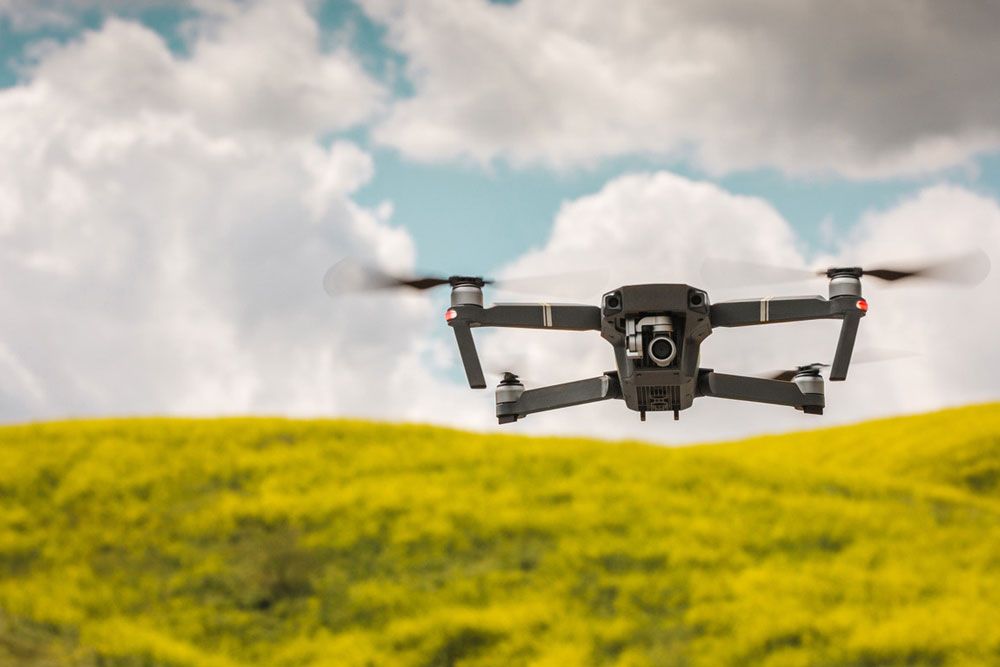Drone photography has become all the rage over the last few years, as it has made getting good-quality aerial shots incredibly quick and easy. To engage in this type of photography, all one needs is a camera mounted on a drone (also called an unmanned aerial vehicle) and a remote controller to direct the device and capture the desired photos and videos. With this setup and certain beginner-friendly tips, one can start capturing stunning views.
1. Explore camera and drone features
To get stunning aerial shots, one first needs to understand a few basic features of a camera and a drone—both essential pieces of equipment for drone photography.
Image resolution
Drone cameras can capture photos and videos at varying resolutions, the most popular being 720p, 1080p, and 4K Ultra HD.
Image capture rate
Drone cameras may also have varying capture rates for videos. Some may be equipped to shoot at 30 frames per second (fps), while others may shoot at 60 fps.
Live streaming
Unlike earlier, when drone cameras could only capture videos on SD cards, today, these videos can be live-streamed on mobile devices. This gives photographers more control over the shots. This feature is available on drone cameras like the DJI Mavic, Phantom, and Inspire series.
Battery
This refers to the total airborne or flight time of the drone. Generally, drones with lithium-ion batteries have a flight time of 7–10 minutes, while those with LiPo batteries can easily fly for 20–25 minutes.
Camera settings
The camera settings required to get the desired shot with a drone can vary greatly depending on the ultimate goal of the shoot. For instance, casual photographers looking for photos or videos that require no editing can shoot in 4k and 30fps in a .MP4 format. They can opt for NTSC as the video system standard and set the white balance to automatic. On the other hand, professional filmmakers who intend to edit and highlight parts of the video later will get better results from shooting in 4k at 30fps in a .MP4 format. The white balance should be manually set here, and the color setting must be changed to D-Log. The style can be set to Custom, 0, -1, -1.
2. Assess needs and skill level
One must opt for a drone that aligns with their requirements and skills. There are two main types of drones to choose from—one with a built-in camera and another in which the camera needs to be attached externally. The first variant is usually bulkier. It also offers lesser resolution than the other variant. So, a crucial tip for drone photography beginners is to invest in a sturdy, light, and cheap drone, as it will be easier to fly. One can also choose from drones based on the type of photography they want to carry out. Some drones are meant for indoor usage, while others can capture large areas like football fields.
3. Read the instruction manual carefully
Reading the instruction guide carefully before operating the drone can answer all the questions one might have about the safety, features, and control of the device. One might also benefit from watching tutorials and reading drone photography guides meant for beginners. All of these resources cover a few key features.
Smartphone feed
This feed is quite useful for beginners, as it helps them understand what the drone is capturing to get the perfect shot.
Smart mode
This is another photography innovation that helps new drone users get the perfect aerial shot.
Tracking
This feature allows drones to follow the smartphone’s GPS, making shots easier to control.
Geofence
A virtually defined geographical area or geofence indicates how far and high the drone can fly.
4. Learn about drone regulations
Drone photography can be particularly invasive if one misuses it. As a result, the government (on all three levels—local, state, and federal) has set some rules and regulations to ensure operators fly drones safely. For example, if one intends to use their drone for any purposes besides recreation, they must apply for a Part 107 certification from the Federal Aviation Administration. Similarly, one must also seek federal registration of drones (with the FAA) weighing between 0.50 and 0.55 lbs. Additionally, the government lays down rules regarding where and when one can fly a drone. Ignoring these regulations is one of the most common mistakes beginners must avoid. So, one must ensure they read and understand all these rules before taking the drone out for a flight.
5. Pick up basic photography techniques
One must remember to consider a few things to get the best pictures and videos using a drone camera.
Camera rules
It is important to remember the fundamentals of photography when using the drone. For instance, one must rely on tried and tested methods such as the rule of thirds, leading lines, and the golden ratio to get the best shot.
Symmetry and patterns
One should be on the lookout for striking colors and symmetry when clicking photos and videos from the sky to get interesting shots.
Speed and stability
When using stable drones, long-exposure shots work splendidly. So, in such cases, one must not rush shots, especially because of a short flight time.
6. Try post-processing
To make the picture or video remarkable, one must spend some time on post-processing. Here, one can remove bits that aren’t required and fix colors to make the visual more vibrant and visually appealing. This skill can take some time to master, but beginners can rely on software like Photoshop and Lightroom to automatically fix the media files.
